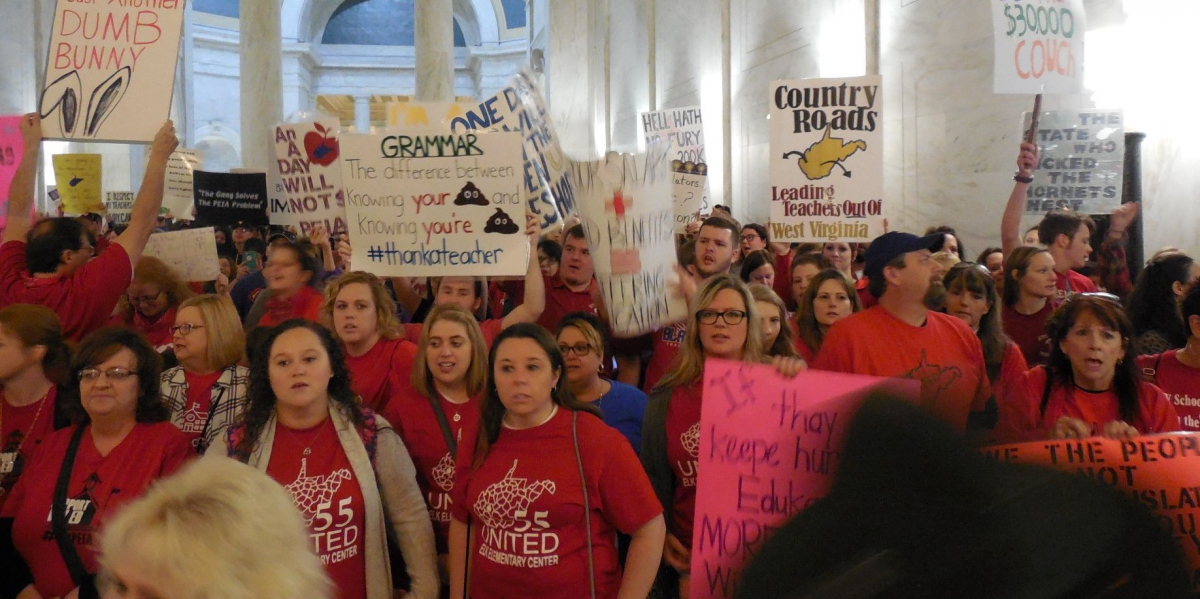West Virginia Teachers Learned from 1970s Miners

The decade-long wave of wildcat strikes in the 1970s and the victories of the Miners for Democracy were a part of West Virginia teachers’ heritage, too. Photo: West Virginia Education Association
As rank-and-file teachers waged their audacious strike in my home state, lots of people cited West Virginia’s stirring labor heritage: the epic mine wars in the 1920s, including the Battle of Blair Mountain, when planes dropped bombs on striking miners, fighting to unionize and end the dictatorship of the coal barons. Teachers proudly wore the miners’ red bandanas as a nod to that history.
But the West Virginia labor history I remember was more recent: the decade-long wave of wildcat strikes in the 1970s and the victories of the Miners for Democracy. That’s part of the teachers’ heritage, too as near to some as a retired dad, if he survived the Black Lung.
In fact, those no-holds-barred wildcats, against both the coal bosses and utterly corrupt—even murderous—union leaders were a big part of the reason Labor Notes was founded, in 1979.
In 1969 thousands of West Virginia miners were on strike, led by disabled miners and widows, not union leaders. They forced the legislature to pass a bill to aid victims of Black Lung disease. On the last day of the year, United Mine Workers President Tony Boyle had his election opponent murdered, and Miners for Democracy was founded right afterwards. It elected a new UMW president in 1972.
Through the 1970s miners kept on with thousands of wildcat strikes, spread through “stranger picketing.” It was simple: if you went to work in the morning and there was a picket line of miners there, even folks you’d never met, you didn’t cross.
These strikes were often provoked by safety hazards—caused by mechanization and speedup—and miners didn’t have time to wait for the grievance procedure. In one big wildcat in 1975, half the UMW’s members were on strike. In 1977, wildcats added up to 2.5 million worker days.
In 1977-78 an official strike of 160,000 miners went on for 111 days, though national union leaders kept trying to settle it with concessions. When Jimmy Carter got an injunction to send miners back to work, they said, “Taft can mine it, Hartley can haul it, and Carter can shove it!”
As they confronted their billionaire employer, coal magnate Governor Jim Justice, in 2018, West Virginia teachers were drawing on that legacy.
REFORM MOVEMENTS EVERYWHERE

SUPPORT LABOR NOTES
BECOME A MONTHLY DONOR
Give $10 a month or more and get our "Fight the Boss, Build the Union" T-shirt.
The 1970s were when reform movements were growing inside the Auto Workers, Steelworkers, and Teamsters, too. “Steelworkers Fight Back” was demanding the rank and file's right to vote on the Basic Steel Agreement and to ditch the no-strike pledge top officials had made. Teamsters for a Democratic Union, founded in 1976, wanted their high-living, mob-connected officials out; one of their demands was an end to the union's rule that contracts could only be turned down by a two-thirds vote. In the early 1970s, the League of Revolutionary Black Workers organized in Detroit auto plants against horrific conditions and complacent UAW officials.
The founders of Labor Notes wanted these reformers, who had so much in common, to learn from each other and to see themselves as a rising labor movement with a new (really, an old) spirit of solidarity.
So we started sending out Labor Notes, subscription price $5 a year.
FACEBOOK WORKS TOO
The striking teachers had communication a lot easier. They made good use of Facebook. That’s more efficient than “stranger pickets”—but what they have in common is trusting people you don’t know yet, simply because they’re your sister or brother.
As the miners’ wildcats spread from mine to mine and the teachers’ strike spread from county to county, we could watch a workers’ movement growing, just as in the 1930s, when workplace occupations leapt from auto plants to Woolworth’s. This time the spark jumped all the way to Oklahoma and Arizona, where teachers started organizing their own protests.
The sparks jumped because experienced activists were there to fan the flames: people who knew what to do and had the vision to do it. Science teacher Rebecca Garelli, who started Arizona Teachers United, had been a rank-and-filer in the Chicago Teachers Union.
It was CTU members, of course, who kicked off the whole teachers movement in 2012 with their own strike. “My Chicago blood got boiling,” said Garelli, “and I said, ‘I’m just going to spark the fire, I’ll be the catalyst.’”
Unions’ job is to train up people like Garelli by getting in fights, and by winning some of them.





